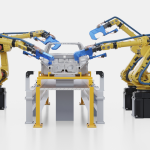Tariffs and shifting demand patterns are pushing warehouses to adapt faster than ever, driving unpredictable inventory swings and labor strain. As warehouse operators face the ripple effects of front-loaded imports and fluctuating volumes, a new approach, layered staffing, is gaining traction. This flexible approach is helping operators respond faster to demand swings without overextending budgets or burning out core staff.
Tariffs and Inventory Surges Are Stress-Testing Warehouse Models
Trade policy has always played a role in supply chain strategy, but its operational impact is being felt more acutely than ever. New tariffs, some anticipated, others abruptly enacted, are pushing importers to front-load shipments, creating ripple effects across U.S. warehouses.
Facilities near ports, particularly in the Southeast and West Coast, are running close to capacity. Inventory volumes are surging, but not consistently, leading to a whiplash effect on both space and labor requirements.
The strategic reaction among many importers has been to front-load inventory, pulling shipments ahead of anticipated tariff hikes to buffer against cost increases. But this has introduced new challenges – bloated inventory levels, constrained storage space, and a mismatch between labor availability and demand peaks.
According to data from Instawork’s 2025 State of Warehouse Labor report, 68% of warehouse operators say tariffs have directly impacted their labor needs this year. More than half have had to adjust labor strategies mid-season to meet volatile demand. What once followed a predictable calendar is now a rolling wave of uncertainty.
While 2023 and early 2024 saw inventory levels swell in response to global disruptions and geopolitical tensions, this year has introduced a more fragmented pattern. Certain sectors, especially electronics, consumer packaged goods, and furniture, still operate above pre-pandemic inventory thresholds. But the volatility has moved beyond product volumes; it’s embedded itself in timing, product mix, and throughput expectations.
The Layered Staffing Model: Building Flexibility Into the Labor Base
To meet this unpredictability head-on, many companies are leaning into a layered staffing strategy – an approach that blends a stable core team with scalable, peripheral layers of seasonal and flexible labor.
At the foundation of this approach are the full-time skilled workers who ensure consistency, uphold safety standards, and carry operational knowledge. The second layer consists of returning seasonal staff, often pre-trained and reliable during known peaks like Q4 holidays. Then comes the most dynamic layer – on-demand labor. This third tier can be deployed rapidly to absorb short-term shocks from trade policy changes, promotional events, or client surges.
The “2025 State of Warehouse Labor” survey report shows that 74% of warehouse leaders using flexible staffing reported reductions in full-time burnout and turnover. But success depends on more than just having extra hands. It requires structure:
- Data-driven planning: Using historical trends and macroeconomic signals (like tariff announcements) to forecast labor needs more accurately.
- Scalable training tools: Implementing digital onboarding methods that make it easy to ramp up temporary workers without draining full-time resources.
- Worker engagement: Treating flexible staff as valued contributors, which leads to stronger performance and repeat participation.
- Tech-enabled visibility: Equipping managers with real-time dashboards that track staffing mix, attendance, and productivity—moving beyond outdated manual methods.
Forward-thinking operators are even building a “bench” of repeat on-demand workers—a trusted group who can be brought back with minimal training, combining flexibility with familiarity.
Engineering Resilience Through Labor Agility
The return of tariff volatility has reignited an old truth – in warehousing, speed and adaptability are competitive differentiators. But agility can’t be reactive, it must be designed. The layered staffing model represents a practical, low-friction way to build resilience into operations without overextending fixed costs or risking burnout.
Crucially, this approach doesn’t replace strategy with flexibility, it enhances it. As warehouse leaders tackle tighter delivery windows, evolving product profiles, and trade unpredictability, the ability to flex labor while maintaining throughput and safety is becoming a baseline expectation, not a bonus feature.





